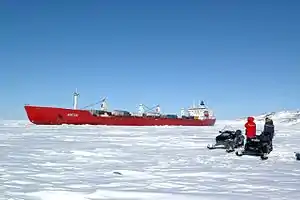MV Arctic
MV Arctic was an icebreaking cargo ship built in 1978 at the Port Weller Dry Docks in St. Catharines, Ontario, Canada. The ship was owned and operated by the Fednav Group. Arctic was sold for recycling in Aliağa, Turkey in April 2021.[3]
 MV Arctic at Voisey's Bay, Labrador, Canada | |
| History | |
|---|---|
| Name | Arctic |
| Operator | Fednav Group |
| Port of registry | Montreal, Quebec, Canada[1] |
| Builder | Port Weller Dry Docks, St. Catharines, Ontario, Canada[1] |
| Yard number | 63 |
| Completed | 1 June 1978[1] |
| In service | 1978–2021 |
| Identification | |
| Fate | Broken up[3] |
| General characteristics (1978)[4] | |
| Type | Ore-bulk-oil carrier |
| Tonnage | |
| Displacement | 39,057 tons |
| Length | |
| Draught | 10.9 m (35.8 ft) |
| Ice class | CAC 2[5] |
| Speed | 3–4 knots in 0.6 m (2.0 ft) ice |
| General characteristics (1986)[1] | |
| Type | Ore-bulk-oil carrier |
| Tonnage | |
| Displacement | 39,427 tons[4] |
| Length |
|
| Beam | 22.92 m (75.2 ft) |
| Draught |
|
| Depth | 15.2 m (49.9 ft) |
| Ice class |
|
| Installed power | 10.9 MW |
| Propulsion | Ducted CPP, ⌀ 5.23 m (17.16 ft) |
| Speed |
|
| Capacity |
|
Designed to carry both oil and ore, the vessel is not only ice strengthened with a Finnish-Swedish ice class 1A Super, but has a CASPPR Class 3 or CAC 4 rating. This means it is powerful enough to navigate through many ice-covered waters without escort. Arctic previously serviced mines in the high Canadian Arctic such as Polaris and Nanisivik. Once those mines closed she was shifted to service the Raglan mine in northern Quebec and the Voisey's Bay mine in Labrador. In addition in 1985 she became the first ship to export crude oil from the Canadian Arctic, from Panarctic Oils Bent Horn terminal.
As part of the repairs following a grounding off of Little Cornwallis Island the ice strengthening in the sides and bottom was increased at Thunder Bay shipyard in 1984. In 1985-1986 in anticipation of the export of crude oil from Bent Horn Island in the high Arctic the ship received a new icebreaker bow and was converted to an OBO at Port Weller Drydock. This improved her icebreaking capability such that the ice class could be upgraded from CAC 2 to CAC 4.[5]
References
- "Arctic (21216)". DNV Vessel Register. DNV. Retrieved 2011-11-21.
- "Arctic (7517507)". Equasis. French Ministry for Transport. Retrieved 2011-11-21.
- "Fednav Welcomes the MV Arvik I—its Newest Icebreaking Bulk Carrier". The Maritime Executive. 29 April 2021. Retrieved 29 April 2021.
- Kitagawa, H. et al. Northern Sea Route. Shortest Sea Route Linking East Asia and Europe. Archived 2011-07-19 at the Wayback Machine Ship & Ocean Foundation, 2001. ISBN 4-88404-027-9.
- Baker, D. & Nishizaki, R. MV Arctic - New bow form and model testing. Transactions - Society of Naval Architects and Marine Engineers, 94, 1986. pp. 57-74.
www.shipbuildinghistory.com/history/canadayards/portarthur.htm C17 348357 Arctic Fednav Ltd. Bulk Carrier 19,420 Jul-85 Conversion to OBO Carrier